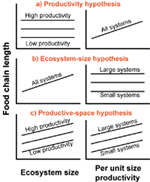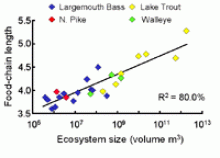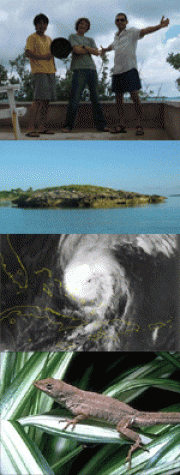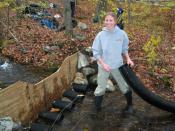Food-chain length
Food-chain length is an important characteristic of ecological communities because it influences community structure, ecosystem function, and contaminant concentrations in many top predators. Conventional wisdom holds that resource availability or dynamic constraints determine food-chain length. The Post Lab is actively testing these hypotheses.
 Resource availability arguments propose that, because a diminishing amount of energy reaches upper trophic levels, food-chain length should increase with an increase in the amount of energy or limiting resources available to top predators. This idea is typically tested by looking for relationships between primary productivity and food-chain length (although as others have noted, variation in ecological efficiencies could be just as important as variation in primary productivity). These energetic based arguments were formalized by Thomas Schoener in the productive-space hypothesis (Schoener 1989). The productive-space hypothesis predicts that food-chain length should increase with the product of ecosystem size (area or volume) and some measure of per-unit-size productivity (e.g., g C m-2 yr-1). The productive-space hypothesis can be tested by looking for a relationship between the productive space (size * productivity) and food-chain length; however, a significant relationship between productive space and food-chain length tells us little about the underlying determinants of food-chain length and can produce misleading results (Post 2007). The better method is to test for the separate effects of ecosystem size and per-unit-size productivity on food-chain length, which provides a better understanding of the underlying mechanisms determining variation in food-chain length (Post 2007).
Resource availability arguments propose that, because a diminishing amount of energy reaches upper trophic levels, food-chain length should increase with an increase in the amount of energy or limiting resources available to top predators. This idea is typically tested by looking for relationships between primary productivity and food-chain length (although as others have noted, variation in ecological efficiencies could be just as important as variation in primary productivity). These energetic based arguments were formalized by Thomas Schoener in the productive-space hypothesis (Schoener 1989). The productive-space hypothesis predicts that food-chain length should increase with the product of ecosystem size (area or volume) and some measure of per-unit-size productivity (e.g., g C m-2 yr-1). The productive-space hypothesis can be tested by looking for a relationship between the productive space (size * productivity) and food-chain length; however, a significant relationship between productive space and food-chain length tells us little about the underlying determinants of food-chain length and can produce misleading results (Post 2007). The better method is to test for the separate effects of ecosystem size and per-unit-size productivity on food-chain length, which provides a better understanding of the underlying mechanisms determining variation in food-chain length (Post 2007).
 The three testable predictions that arise from independent consideration of ecosystem size and per-unit-size productivity are that food-chain length could be determined by 1) productivity alone (the productivity hypothesis), 2) by ecosystem size alone (the ecosystem-size hypothesis), or 3) by a combination of productivity and ecosystem size (the productive-space hypothesis) (Post et al. 2000). The productivity and productive-space hypotheses both derive from the original resource availability arguments; however, the productivity hypothesis does not explicitly include ecosystem size as a determinant of resource availability. The ecosystem-size hypothesis is based on the relationship between ecosystem size and species diversity or between ecosystem size and habitat availability and heterogeneity. The ecosystem-size hypothesis does not explicitly include resource availability as a direct determinant of food-chain length, although resource availability could indirectly contribute to variation in food-chain length (Post 2002).
The three testable predictions that arise from independent consideration of ecosystem size and per-unit-size productivity are that food-chain length could be determined by 1) productivity alone (the productivity hypothesis), 2) by ecosystem size alone (the ecosystem-size hypothesis), or 3) by a combination of productivity and ecosystem size (the productive-space hypothesis) (Post et al. 2000). The productivity and productive-space hypotheses both derive from the original resource availability arguments; however, the productivity hypothesis does not explicitly include ecosystem size as a determinant of resource availability. The ecosystem-size hypothesis is based on the relationship between ecosystem size and species diversity or between ecosystem size and habitat availability and heterogeneity. The ecosystem-size hypothesis does not explicitly include resource availability as a direct determinant of food-chain length, although resource availability could indirectly contribute to variation in food-chain length (Post 2002).

There have been few empirical tests of these food-chain theories primarily because it is difficult to estimate both ecosystem size and food-chain length in natural ecosystems. Working in northern temperate lakes, Post et al. (2000) tested the productive space hypothesis using stable isotope techniques to determine food-chain length and by taking advantage of the relative isolation of these lakes to estimate ecosystem size. Post et al. (2000) estimated food-chain length in 25 north temperate lakes ranging across independent gradients of volume and per-unit-size productivity. They found that food-chain length increased with ecosystem size, but was not influenced by productivity. The increase in food-chain length was caused by both the addition of new top predators to the food web and a general increase in the trophic position of all top predators. These results challenged the conventional wisdom that energy or resource availability limits food-chain length, and identified a new direction for research in this area of community ecology.
The importance of ecosystem size in determining food-chain length has also now been shown in terrestrial ecosystems. On islands in the Bahamas, Gaku Takimoto, Dave Spiller and David Post have found that ecosystem size also determines food-chain length (Takimoto et al. 2008). This is the first study, since Schoener’s original paper, to show the effect of ecosystem size on food-chain length in terrestrial systems.
The Post Lab has also tested Pimm and Lawton’s (1977) dynamics constraints hypothesis, which suggests that food webs subject to more frequent or more intense disturbance should have shorter food-chain length.
 Gaku Takimoto tested this hypothesis on islands in the Bahamas (Takimoto et al. 2008) and Annika Walters tested the hypothesis in streams in Connecticut (Walters and Post 2008). Contrary to conventional wisdom, disturbance was not found to be an important determinant of food-chain length in either system. In both cases, the complexity of the food web (complexity not included in the original theory) compensated for species loss caused by disturbance and prevented a decrease in food-chain length.
Gaku Takimoto tested this hypothesis on islands in the Bahamas (Takimoto et al. 2008) and Annika Walters tested the hypothesis in streams in Connecticut (Walters and Post 2008). Contrary to conventional wisdom, disturbance was not found to be an important determinant of food-chain length in either system. In both cases, the complexity of the food web (complexity not included in the original theory) compensated for species loss caused by disturbance and prevented a decrease in food-chain length.
In collaboration with John Sabo, Jacques Finlay, and Theodore (Ted) Kennedy, the Post Lab tested the role of disturbance, ecosystem size, and resource availability on food-chain length in rivers across North America. This continental scale, NSF funded collaborative project evaluated, in a single study, the interactions among resource availability, ecosystem size and dynamic constraint - an important next step towards advancing our understanding of the factors determining food-chain length (Post 2002). Sabo et al. (2010) found strong effects of ecosystem size and disturbance, but not resource availability, on food-chain length. Sabo et al. (2010) further found that the influence of ecosystem size on food-chain length was partially caused by the influence of ecosystem size on disturbance, in the form of discharge variation in this study.
In response to these empirical results, Gaku Takimoto and colleagues developed new theoretical models that better match the food web complexity observed in natural systems to evaluate how ecosystem size, resource availability, and disturbance influence food-chain length (Takimoto et al. 2012).
Finally, Takimoto and Post (2013) have recently published a meta-analysis for the determinants of food-chain length using studies from a wide range of ecosystems. They found a strong, but variable, effect of ecosystem size, no consistent effect of disturbance, and a weak but consistent effect of resource availability.
Related publications (Post Lab publications):
Takimoto, G. and D.M. Post. 2013. Environmental determinants of food-chain length: a meta-analysis. Ecological Research 28:675–681. doi:10.1007/s11284-012-0943-7
Takimoto, G., D.M. Post, D.A. Spiller, and R.D. Holt. 2012. Effects of productivity, disturbance, and ecosystem size on food-chain length: insights from a metacommunity model of intraguild predation. Ecological Research 27:481-493. doi:10.1007/s11284-012-0929-5
Sabo, J.L., J.C. Finlay, T. Kennedy, and D.M. Post. 2010. The role of discharge variation in scaling of drainage area and food chain length in rivers. Science 330:965-967. doi:10.1126/science.1196005
Takimoto, G., D.A. Spiller, and D. M. Post. 2008. Ecosystem size, but not disturbance, determines food-chain length on islands in the Bahamas. Ecology 89:3001-3007.
Walters, A.W. and D.M. Post. 2008. An experimental disturbance alters fish size structure, but not food chain length in streams. Ecology 89:89:3261-3267.
Post, D.M. and G. Takimoto. 2007. Proximate structural mechanisms for variation in food-chain length. Oikos 116:775-782.
Post, D.M. 2007. Testing the productive space hypothesis: rationale and power. Oecologia 153:973-984.
Post, D.M. The long and short of food-chain length. 2002. Trends in Ecology and Evolution 17:269-277.
Post, D.M., M.L. Pace, and N.G. Hairston Jr. 2000. Ecosystem size determines food-chain length in lakes. Nature 405:1047-1049.
Food web dynamics
The Post Lab has also worked to develop theory on how food web structure and species interactions may alter food web dynamics. These models expand upon previous efforts by broadening food web structure and by including behavioral interactions between species. The models show that common ecological processes, such as prey preference, can dampen food web oscillations and increase food web stability. Our results highlight the importance of variable behavior by predators that link disparate habitat patches or food webs. They also support the idea that it is the way in which species interact, rather than the number of species in a food web, that most strongly influences food web stability. Our work also has important implications for understanding the dynamical implications of food web structure, and the structural implications of food web dynamics.
Related publications (Post Lab publications):
Takimoto, G., D.M. Post, D.A. Spiller, and R.D. Holt. 2012. Effects of productivity, disturbance, and ecosystem size on food-chain length: insights from a metacommunity model of intraguild predation. Ecological Research 27:481-493. doi:10.1007/s11284-012-0929-5
Post, D.M., M.E. Conners, and D.S. Goldberg. 2000. Prey preference by a top predator and the stability of linked food chains. Ecology 81:8-14.